(Greetings friends, fans of Nopalito and Native Plants, it’s been a long time since we last talked…..Nopalito Native Plant Nursery has been closed for over 2 months now, my body has gotten a good rest, but my mente and corazon, my head and heart have hurt……mucho……no regrets closing the nursery, but in all honesty, we we’re going bankrupt, losing money, health and days we will never get back…….but we did amazing things, and by we i mean everyone…..I will be sending out an email to stay in touch soon thru our email list, and I hope to do more of this blog business, too, but for now I’m doing more of what I hadn’t done much of in the past few years…..touch, taste and work with native plants…..funny how you can be surrounded by native plants in your own nursery every day, on your way to work every day, and almost never really touch them, use them, talk to them……I’m glad that has been changing……thank you for all your past support, please keep in touch, feel free to ask questions about your natives or send a picture so I can see how all the natives are doing……Below is a poem I wrote about wanting to be a native plant, I don’t know what the hell I’m thinking about when I write this shit, and why am I sharing it with you?!?! probably cuz’ God was tired of listening, feel free to unsubscribe to this blog if it’s too ridiculous for you, or better yet, share with me some of your own plant poetry, I’d love to read it…..happy rainy season {it’s almost time to welcome those rains!} hope you and your families are well….Antonio)
——————————————————————————————————————————————————————————————————————————————————————————————-
I want to be a native plant…….
there are thousands……….pick one, any one.
Just make sure I’m from California……..And Make Me PRETTY
not necessarily to people…….humanos……..Americanos………Mejicanos (they’re all the same to me anyways, until they begin to talk to me…….to offer me gifts…….to pray with me…..)
Just make me pretty……to whoever I need to be pretty to
If ya gotta make me pretty like THAT……so that the bees and butterflies can take me out to dinner, have a one night stand and never call again – THEN DO IT
If I have to be a native annual, that rises with the FALL and falls face first in the heat, THEN DO IT (I’ve been looking forward to a long nap next to old friend Sagebrush anyways)
If I gotta be pretty enough to JUMP OUT at blind folks while I’m sitting in a pot on some random Home Depot shelf, then just fucking do it already.
But if there’s time…..If I could just pick WHICH plant I could be……..I wouldn’t be the prettiest (to human eyes)
I wouldn’t be the black oak that could tell a thousand grizzly bear stories, or the white sage that atheists burn to find heaven.
NO
if i can choose to be any native plant (And I’m assuming you’re gonna let me because the night is still young),
I WOULD CHOOSE TO BE THE PLANT THAT MAKES CHILDREN UNPLUG THEIR X-BOXES.
THE PLANT THAT MAKES BIRDS WANT TO USE TWITTER.
THE PLANT THAT MAKES RAIN WANT TO CRY.
MAKE ME the plant that can supply a nation of millions with countless baskets of food……….fire for warmth……….and a tea that will help the kids of the ’90’s talk to ALL of California 520 years ago…..NAM-BAY WAY-A……HEY!…Mr. Black Bear, it is good to see you!…..Saludos!, Mama Salmon! and Welcome, Children of the Acorn and People of the Sun!
But,
if this is all too much.
too complicated.
just not possible in the year 2012.
IF NO WIKIPEDIA PAGES EXIST ON SUCH A CALIFORNIA NATIVE PLANT.
…….then I want to be the first leaf to touch my childs lips, and the last one to bless my partners’ soul.
fin
At our nursery in Ventura (Nopalito Native Plant Nursery), selling native plants to people can sometimes be AGONIZING! Te lo juro,I swear, sometimes we get customers who want it all, and by ‘it all’ I mean a lush green plant with 49 months worth of flowers a year (do the math, that’s a lot of months) and no water and low maintenance and can it solve our budget crisis and can it go vote for me on election day?, etc. It’s overwhelming sometimes, but it brings up a point……we here in So. Cal. have been so spoiled with our decades and decades of tropical gardens and their endless flowers and greenery that anything else seems uncivilized (old spice reference, anybody remember those commercials?). It’s kinda like drinking sweetened, milky, sugary coffee all your life, and you’ve never tried delicious, fresh-ground BLACK coffee. Then, one day, someone hands you a cup of ‘blacker than the night itself’ cafecito and what happens? Your 45 years plus of drinking milky-sugary-goodness kick in and you probably think black coffee is bitter, acidic, nasty, i want my money and taste buds back. I think that is the reaction that a lot of people have when they see most of our states’ native plants. Sometimes I can see new customers walking around thinking “Pass the sugar and half and half, please!”. Actually, since we are a native plant nursery and next to a health food store it is probably stevia and almond milk they want you to pass, but you feel me, right? Well, I am not here to talk about how we got to this point, that is WAY too political and historical for this one little blog entry (but don’t worry, I’ll tear that up soon!). Instead, we in the low-water industry find ourselves scrambling to present plants to ‘ween’ people to a cleaner, blacker coffee (is anyone still following this crazy comparison?, and if so, pass the soy milk!) So, while you, the public, adjust fairly quickly to a new type of morning brew, may I recommend a local native that will ease the transition?……Poison Oak! No, not really, but damn that is one of the prettiest natives in the fall when it goes dormant……again, I gotta save it for another blog-
Hummingbird Sage!…… or Salvia spathacea, is one of our Top Cinco selling California native plants at the nursery, and it is found in our local hills! It always makes me a little extra-contento when we sell our local Ventura County plants to gardeners. It’s kinda like seeing someone from your family or school make it big somewhere, like local USC boy Mark Sanchez if the Jets would’ve made the SuperBowl (next year, Sancho!). Hummingbird Sage is found from about Central California down in to San Diego, and I think it might even be across the border in TJ partying like a rock star. CalFlora has a pretty neat map (click here) of where this superstar is found in the wild. So why is this a good Mocha-Latte alternative? First of all, let me get this off my chest. Few native plants look as good or perform as well in large pots as Hummingbird Sage. Check out our wine barrel full of Salvia spathacea at the nursery(click on pictures to make them BIG)
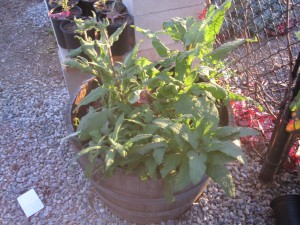
I know what you’re thinking, and the answer is yes, we did drink all the wine before chain-sawing that barrel in half. The reason ‘spath’ works so well in a pot is that it spreads or grows underground. If you have ever seen mint or even weedy lawn grass spreading and popping up everywhere, then you have seen a plant spread rhizomatously (big word, check wikipedia for correct spelling). Before you worry about this becoming a weed, don’t trip potato chip! This plant doesn’t spread overnight, but just fast enough to fill up a large pot fairly quickly and make you look like a design genius. The reason the chuparosas (hummingbirds) like it is those darn flowers – big, fat, reddish pink and usually from Winter to Late Spring. Here’s a sideways picture of the flowers, because I am much better at plants than I am at mastering cameras and technology.


Usually the first flowers show up in mid-late Winter, sometimes earlier, and with a little pruning on your part, they can last into June or longer. Not bad for a plant that is found in our dry hills, under Oak trees, with no measurable rain for 6 months plus! Now if you get lost in our hills around September, you might not even notice this little bastard, it can look very dried up and shriveled from no water. Don’t worry, that’s how the plant deals with stress, kinda like how you might reach for a cigarette, beer or a latte to deal with stress. The thing that sets ‘spath’ apart from some other natives is that if you give it a little water during the dry times, it responds by flowering longer and staying green all year! Let me repeat this, because this is a huge lesson of native plant gardening – Many of our native plants are used to getting no rain for 6 months or more, and going dry and looking a little ‘ratty’ is one of the ways they protect themsleves. (Trust me, if you got no rain for 6 months out of the year, you would look a little ratty too…..I’m just saying!) BUT, (for certain plants) if you take that same plant, add one part water hose during the dry season, two parts pruning of the dry flowers, and a dash of sugar and a teaspoon of half and half (you thought i forgot about the whole coffee thing?!?!) they respond like this
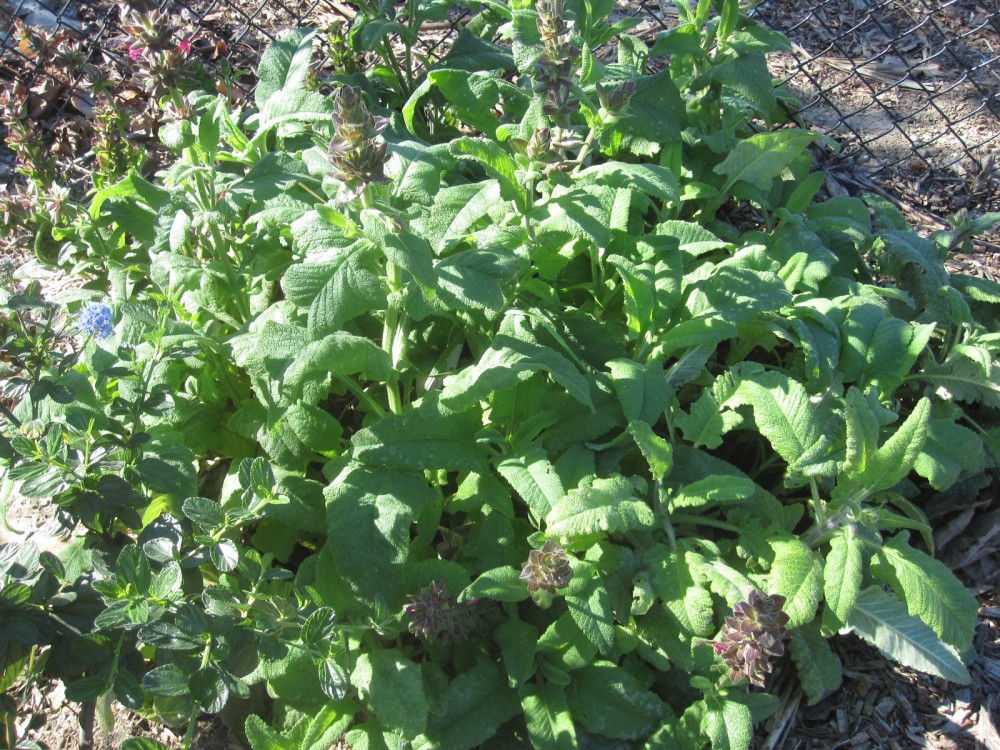
Suck it, dry season! Above is a picture of our hummingbird sage, looking lush and green in the ground during December, and just starting to flower. We planted this one plant last February, and with very little water (maybe 4 waterings all of 2010) it kept the nursery looking good and the hummingbirds super-full, all Summer!
Ok, so ‘Spath’ feeds hummingbirds and responds well to a little water…….why else would you want to grow it? Well, it makes one of our best ‘groundcovers’ for under oak trees, kinda-shady areas and even full sun near the coast. It’s fast growing, but not TOO fast, and don’t forget about Hummingbird Sage Tea baby?! Yup, the leaves smell sweet and wild, like a mango fell in the redwoods and no one was around to hear it, and tossing a few leaves into some hot water makes a delicioso tea that you can probably sell for $5.00 a cup if you’re smart and have a local food restaurant. All the while, the leaves stay about 8 inches to 2 1/2 feet tall, with the flower spikes climbing a foot or more above the leaves. One of the few yellow flags about this plant is powdery mildew. Direct your ojito to the photo below, the whitish spots on the leaves are powdery mildew
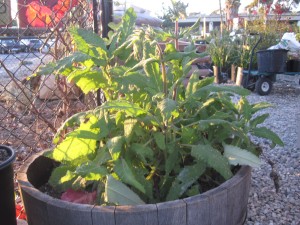
Powdery Mildew usually happens for one of 2 reasons on Hummingbird Sage – It’s in a very, very shady situation where the leaves don’t get a chance to dry out and breathe, or it gets too much overhead water, and the consistently wet leaves turn whiter than a Full Moon. Either way, the problem is usually only minor and seasonal and will most-likely disappear after the rains do, but serious problems should be addressed by changing your watering habits or relocating the plant. There are many organic methods to address good old powdery mildew, click here to read about one. I have to confess, though, that for myself, being a native plant gardener truly is about low-maintenance, SMART gardening and straight-up black coffee! That kinda means ‘lazy’ gardening to some people, as I am willing to put up with a little seasonal powdery mildew because I know that, come the dry season, these plants will be clean and beautiful. That’s the great thing about almost all native plants – Right place, right plant! If you find the right place for the right plant, your worries about pests and diseases almost disappear! Coming form the ‘traditional’ farming and gardening world (i.e. lots of compost, fertilizer and water), I know that if you force a plant from Brazil or Southern Mexio to grow here, where it would never, ever exist on its own, you are INVITING pests and diseases to show up to your fertilizer & water parade! But growing plants like ‘Spath’, that probably exist a few miles from our nursery or your house in the wild, is as good as putting money on the Packers to win the Super Bowl (Sorry Steelers fans…..Packers 27, Steelers 20) . So, use ‘Spath’ like crazy in large pots, as a shade tolerant groundcover, and don’t worry about giving it a litte extra water to keep it flowering and growing strong. And guess who will be talking about ‘Spath’ and other great local natives on Saturday, February 5th? Yours truly, in Ventura…..Yeah, they couldn’t find anyone better to bore you about native plants. Click here for all the details. Thanks for reading, as always, Plant local, Enjoy local wildlife!
I have to admit, I love the end of the Calendario Year, Christmas and New Years stuff everywhere, it’s kinda fun, kinda sad, kinda uncomfortable to see how different people handle the whole ‘Holiday’ thing …….Merry Christmas? Happy Navidad? Merry Solstice? – But I love the food, Tamales all warm and toasty, Hot Chocolate……wait, is this a native plant blog? Hold up, just one more sip of Chocolate……AHHH, ok, here we go!
One of my favorite things about the end of the year are all of the experts and their Top 10 Lists or End of the Year Lists, like the ’10 Best Cute Kitten Videos of 2010′, or the ’10 Best Lady Gaga Outfits of 2010’……you get the idea. I wonder what people did way back in the day, like 6 years ago, when they didn’t have access to all of this info., pictures and videos…….Maybe they talked about their experiences, like the ones we have been having at the nursery this past year. While I don’t have a Top 10 List (too poor), I do have 3 plants that are either new, really hard to find or I just never used before and that I have completely fallen in love with this past year, and I wanted to share them with you in case you haven’t tried them (then you can come into Nopalito Native Plant Nursery in Ventura and spend lots-o-money, and come say hi!….but mostly buy the plants) – Here We Go!!
1. Ceanothus impressus ‘Vandenberg’ – Ok, I gotta be honest, i feel like a plant stalker. I can’t get this plant off my mind! At least once a week I check out this plant in the front of our nursery, and I’m pretty sure it’s gonna put a restraining order on me in the next few days. I’ve had my eye on this plant since I visited Native Revival Nursery up in the Bay Area in 2009 (you’ve got to check this place out if you ever get up there!). This pretty little thing caught my eye there for a few reasons – It was small for a Ceanothus, which is like saying 95 degrees is cool for a Phoenix Summer. The 5 year-old plant I saw was about 3 1/2 feet tall, about 5 feet wide and had a really neat growth habit. The tiny leaves were dark green (nearly a shade of black), and I almost went out that day to get a tattoo of this little Ceanothus. For those of you who don’t know, the size I described is pretty small for a Ceanothus, they are usually pretty big and even wider. The gorgeous purple-blue-violet flowers are usually enough to make people try to fit a big Ceanothus plant in their garden, but more often than not Ceanothus can be too much for a small garden to handle. So I was super-contento when i saw this sucker, which was selected and collected at Vandenberg Air Force Base by hard-core native plant gangster M. Nevin Smith in the early 80’s. I got to plant a few in our heavy clay soil in midtown Ventura back in February, and I have been very happy with the results (click on all pictures to see close-ups)…….

Of course, having had less than a year expereince with this plant I can’t say I know everything about it, but doing some internet research and reading some native plant books, along with my year-long love affair, has taught me this – This Ceanothus likes our part of Southern California, like a surfer who is never really happy kickin’ it in Las Vegas all summer, this plant seems to like to be near the coast, feeling the morning fog and probably not liking the extreme heat of some of our interior valleys – ‘Vandenberg’ doesn’t mind clay soil, as long as you keep it dry and fairly well-drained – We are a little crazier here at the nursery than most folks, when we say low water we mean low water, so we watered this plant in a few times very deeply and then let it go – Since last February, we watered this plant no more than 5 times total (take that Phoenix!) – I think our clay soil is making this guy grow pretty fast, where it seems to be growing slower in sandy or rocky soils – Below is a picture of what our plant looks like 10 months later, with 5 waterings all year, in full sun in Ventura – I am surprised at how many people are attracted to this plant, even though it has yet to flower for us (Dark Blue flowers, probably March-April), imagine when it does finally go off! I think this little baby would work very well in Ventura, Oxnard, Camarillo, Malibu, Newbury Park and places like it that get some coastal influenece – I think a key to making it live long and thrive is to keep the water to a minimum, which means water it maybe just a few times a year, during the dry Summer season. With a final size of about 4-5 feet high and slightly wider, this plant could be very useful as a small hedge, under a window, maybe even used by local cities in parking medians and other places where a low-water, low maintenace shrub can be handy. Remember, Butterflies love Ceanothus flowers, and this evergreen beauty will provide a place to hide and hang out for bees, insects, birds, etc. Love it, Plant It!

2. Eriophyllum staechadifolium ‘Compacta’ – I dare you to say the scientific name of this plant fast, 5 times…….with peanut butter in your mouth! The Latin name of this plant is a mouthful, but the common name is pretty cool – Lizard’s Tail. Lizard’s Tail is found throughout California, up and down the coast, and usually in sandy or well-drained soils. This ‘Compacta’ version is supposed to be more tidy and compact than the wild version. We got ‘Compacta’ from our friends at Native Sons Nursery in Arroyo Grande, planted it in our heavy clay soil in April as a little 4 inch plant and check out the results…..
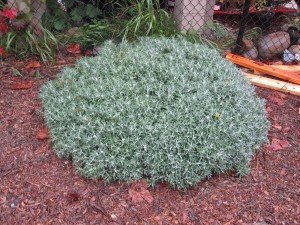
BAM! This plant grew like it was on steroids, quickly reaching the 1 foot high by 2 foot wide description on the label, and then of course it got even wider and a little taller. By June it was flowering with beautiful, clean yellow flowers that look a little like yarrow flowers and a little like butterfly happy hour bars, which is what it attracted like crazy. By July it was in full flower, and we cut off the dead flowers twice during the Summer and this low-water marvel flowered straight thru October. Oh yeah, that whole time we watered it twice, including when we planted it. I told you we were hard core. Look at the plant one more time –
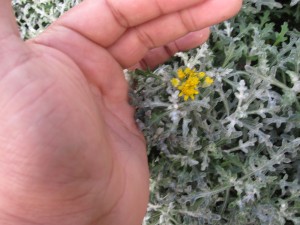
Those leaves are pretty cool, if I was a garden writer i might use words like ‘lacy’ or ‘frosty’, but since I’m not I’ll just say that they grayish leaves are pretty enough to melt Frosty the Snowman’s heart and the way the foliage stands out makes you want to turn away from those Cagney and Lacey reruns………Yes, I used Frosty and Lacy! Ok, bottom line is this – This fast-growing, butterfly attracting, long-flowering plant has been super easy for us, and it needs to find more homes locally, especially near the coast. I have never grown the ‘regular-wild’ version of this plant, but from what I am thinking this plant can rock in hotter areas, probably with well-draining or dry soil and a little summer relief (light waterings, a little shade). For us along the coast, I fantasize about using this plant with purple and/ or blue flowering plants, like ‘Winnifred Gilman’ Sage, Caryopteris ‘Dark Knight’ (it’s not native, uh-oh!) or even Salvia ‘Midnight’ Mexican Sage (you got a problem with Mexican……..Sage?). Or maybe even with Ceanothus impressus ‘Vandenberg’, I heard from a really great writer about how neat that plant is, now where did i read that??? The possibilities are endless with those gray leaves, rounded shape and bright yellow flowers. New plants like these are one of the many reasons native plants are so exciting – There are beautiful plants in every corner of the state, we just have to be willing to look for them and try them! Here’s one more picture of this plant, it’s in the lower right corner, next to a ‘Roger’s Red’ Grape Vine that is going dormant and looking pretty good too!
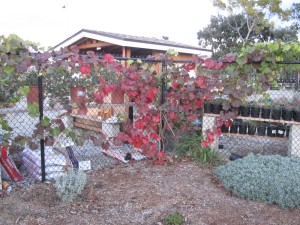
3. Eriogonum x bliassianum – The name of this buckwheat hybrid is fun to type, mostly cuz’ it makes me feel like I did pay attention in all of those Botany classes and I didn’t drop out to start a native plant nursery. When you use an X in a Latin name, it means that plant is a Hybrid, kind of like this – Toyota x Prius…….hah hah, get it, a hybrid car? Man, these jokes are horrible, let me get to the damn plant for those of you still suffering thru this. As you might know, I love the buckwheats, I would love to see tons of ugly plants torn out and replaced with native buckwheats – Let’s get rid of those big ugly oaks that shade everything out in Ojai and replace them with buckwheats…….Anyways, the buckwheats are awesome, and 2 of my favorites are Eriogonum giganteum (St. Catherine’s Lace)
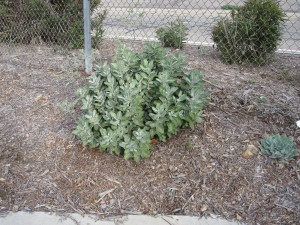
AND Eriogonum arborescens (Santa Cruz Island Buckwheat)
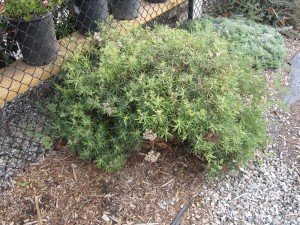
You gotta love St. Catherine’s for her beautiful grayish leaves, big fast size and huge flower clusters (umbels, but I’m a Botany drop-out, remember?) and you gotta love Santa Cruzita for her long flower period, beautiful white-pink flowers, unique rosemary-like leaves and her twisting, shredding bark. Oh yeah, both of these plants need almost NO summer water to look good and they both flower in the Summer! So, what happens when these 2 plants meet at a bar (or a Dodgers game) and take things back to the hotel room? Well, besides arguing about who is the greatest Dodger ever (Steve Sax anyone?) they get down and have little Buckwheat Babies, which is what Eriognum x blissianum is. Think Brad Pitt and Angelina Jolie, now think about how cute their kids are……this buckwheat hybrid is easily as cute as those kids………

The leaves on Eriogonum x blissianum are so lush and green they almost look like our native Black Sage or Brandegee Sage, and like it’s parents it has been flowering for a long time, since the Summer! These plants were planted back in June and July, growing quickly to 3 feet high and wide and I expect them to get bigger and wider! I love this plant – it makes a good cut flower, flowers brightly for months, feeds local insects, is low-low water (once a month during the summer) and it is really hard to find this plant, even in native plant nurseries. In fact, it’s so rare that I hope you don’t like it too much cuz’ we are sold out and it might be months or even years before we get more. Speaking of years, I imagine this plant can be long-lived, like it’s parents. Also, one of my favorite things about Santa Cruzita Buckwheat is its twisting, shredding bark, that shows off more and more with age. Here’s how our Eriogonum arborescens (Santa Cruzita) bark looks after only a year………
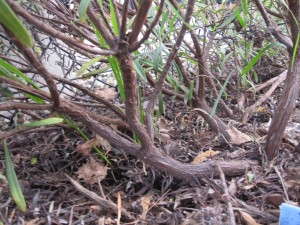
Eriogonum x blissianum is planted so infrequently and so rarely that I can’t say if it will display the same trait, but I’ll let you know in a few years! One downside to this plant might be its’ vulnerability to downy mildew, talked about here in this article from the Santa Barbara Botanic Garden. We have yet to hear from our customers if this has been affecting their plants, and ours are clean and beautiful, but it is definitely something to keep your eye on. Like Santa Cruzita, I think ‘blissianum’ would look spectacular in a large pot, or try Eriogonum x blissianum on a hillside where you water as often as our country has a president who isn’t white (Political and Funny!), or use it as I have seen arborescens used, as a beautiful semi-formal hedge that flowers for months, attracting butterflies, bees, and looks very nice the rest of the time. Here’s one more picture, close-up.
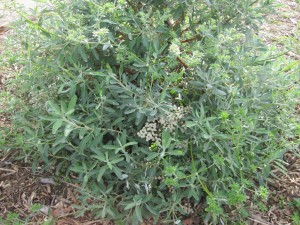
Well, that’s my list of the 3 native plants I got to try this year for the first time and fell in love with, what plants did you fall in love with this year? I would love to hear from you about your favorite plants of 2010, and 2011 is looking like a great year as well. I’ve already planted a new Ceanothus that looks to be pretty cool, along with new Monkeyflower Hybrids and a Silver-Blue version of one of my favorite native grasses, California Fescue. Happy New Year everyone, and as always, Plant Native, Enjoy Life!!
Ok, this blog has nothing to do with racism, but it got you to pay attention, right? Actually, I’ve been thinking and tripping out a lot lately on water……Yes, of all the things to trip out on, my ridiculous mind has to settle on water! Rain, oceans, the main ingredient in beer, water is awesome. Owning a native plant nursery and being a lover of California native plants, I almost have to be into water and water conservation. It’s like growing up in West Texas and being a fan of Tejano or Country Music and Fajitas. Speaking of West Texas, that’s where this little trip-out session begins……
I grew up in El Paso, home of the UTEP Fighting Miners, lots of good Tex-Mex Food and a town full of hippies. Yup, you would never know it but me and my neighbors, all 700,000 of them, were a bunch of pot-smoking, long-haired hippies. Don’t let the flag-waving, beef-eating, football-loving stereotype fool you……Every person in El Paso was and is a hippie. A quick drive around any El Paso neighborhood (or any ‘desert’ city, for that matter) will show you the same thing – Small Lawns, Lots of native and drought-tolerant plants, and malls, government properties and even huge mansions all with the same type of low-water landscaping. Water Conservation and caring more about your water supply than how many pretty flowers you have are classic signs of a hippie community! Let’s compare El Paso to the supposedly ‘green’, ‘liberal’ and ‘hippy’ Southern California. A quick drive around the City of Ventura will reveal just the opposite of my hometown – Malls and shopping centers with almost every kind of landscaping imaginable, government properties with huge amounts of lawn (wait, maybe that’s a golf course) and huge mansions with even huger (that’s not a word!) water bills. Average yearly rainfall in El Paso is 9 inches, Average yearly rainfall in Los Angeles is 14 inches. Using my ridiculous math skills that means that Southern California, on average, gets 5 more inches of rain a year than El Paso!
Now that I think about it, my people back in El Paso actually weren’t all hippies (they were Chippies – Chicano Hippies!), they have simply learned to live with what they have. Yes, we were probably forced to live with this reality by high water prices and strict watering restrictions, but the fact of the matter is that water conservation is a way of life in El Paso. It doesn’t matter if you are a Conservative, a Liberal or whatever Obama is choosing to be these days (Ouch!), 9 inches of rain a year is 9 inches, there ain’t no changing that! Now, I am no water expert, no scientist, not even a botanist, and if I go to Arizona I am not even a U.S. Citizen, but I am smart enough to know this – We and the rest of Southern California need to get to where El Paso is. We need to be able to wake up every morning and make water conservation a part of our life, without thinking about it. We need to accept where we live, and realize we can’t keep taking unlimited amounts of water from Sacramento or from our own groundwater supplies without consequences. And don’t worry all of you who fear that your property values will go down because of all the cactus and mesquite trees that will be moving into your neighborhood; As far as landscaping goes, Ventura County will never look like Phoenix or El Paso, mostly because many of those desert plants don’t grow well out here. Along with much cooler summer temperatures, our spoiled landscapes get a lot of their moisture from just being close to the ocean and being able to kiss the fog every night (damn that was poetic). But on the flip-side, El Paso and other desert cities can get flash floods in the summer from all of those big monsoon storms, something that would be almost impossible to get here in Southern California because we receive almost no rain from May-October (That’s 5-6 months of no rain, that means our native plants have evolved with this dry time! Can you imagine not watering your current garden for 5-6 months?). So what’s the point of all of this rambling? Well, my hope is that we all become El Paso-type hippies soon and learn to love Fajitas……I mean, live within our water means. That would be a huge first step. Let’s all appreciate that we are not in a desert, but our home is desert-like. Let’s be proud of our Mediterranean Climate and what it means for ourselves, our families, and our futures. It’s crazy to think that planting one native plant or one small low-water yard can make a difference, but it can. I read somewhere that over 50% of the water used by homeowners in Southern California is used outside the house on landscaping. While I am not exactly sure how true this is (because it wasn’t on Wikileaks), it is probably more true than false. Just like the landscaping in El Paso and other desert cities blends in with the surrounding landscape, the day is coming that gardens in Southern California will reflect our local hills and canyons. Who knows, your front yard may have once been home to some white sage, lemonadeberry or an oak tree, providing food for people and wildlife. And even more importantly, maybe its’ time to bring those old friends back……Plant Native, Enjoy Life!














